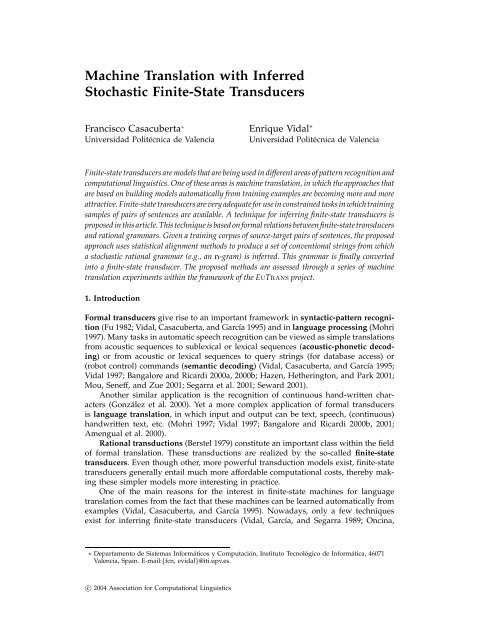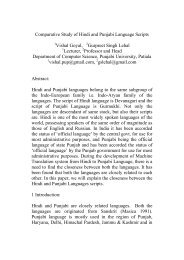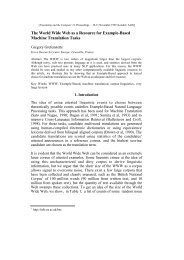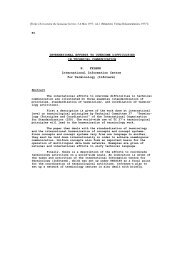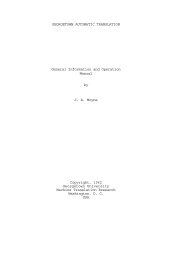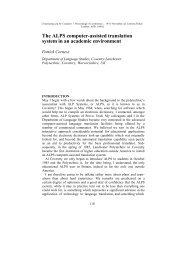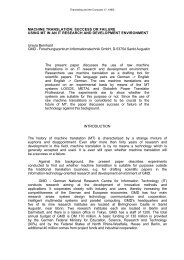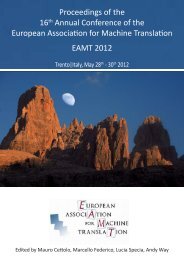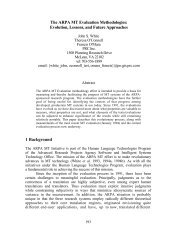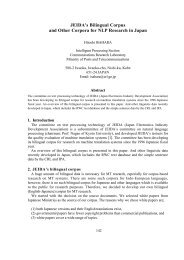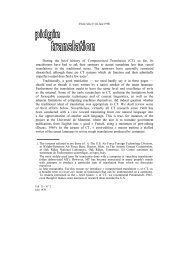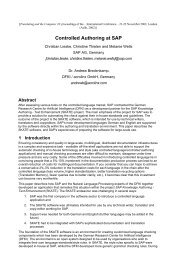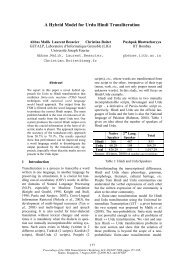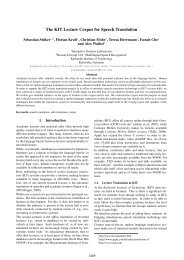Machine translation with inferred finite-state transducers
Machine translation with inferred finite-state transducers
Machine translation with inferred finite-state transducers
Create successful ePaper yourself
Turn your PDF publications into a flip-book with our unique Google optimized e-Paper software.
<strong>Machine</strong> Translation <strong>with</strong> Inferred<br />
Stochastic Finite-State Transducers<br />
Francisco Casacuberta ∗ Enrique Vidal ∗<br />
Universidad Politécnica de Valencia Universidad Politécnica de Valencia<br />
Finite-<strong>state</strong> <strong>transducers</strong> are models that are being used in different areas of pattern recognition and<br />
computational linguistics. One of these areas is machine <strong>translation</strong>, in which the approaches that<br />
are based on building models automatically from training examples are becoming more and more<br />
attractive. Finite-<strong>state</strong> <strong>transducers</strong> are very adequate for use in constrained tasks in which training<br />
samples of pairs of sentences are available. A technique for inferring <strong>finite</strong>-<strong>state</strong> <strong>transducers</strong> is<br />
proposed in this article. This technique is based on formal relations between <strong>finite</strong>-<strong>state</strong> <strong>transducers</strong><br />
and rational grammars. Given a training corpus of source-target pairs of sentences, the proposed<br />
approach uses statistical alignment methods to produce a set of conventional strings from which<br />
a stochastic rational grammar (e.g., an n-gram) is <strong>inferred</strong>. This grammar is finally converted<br />
into a <strong>finite</strong>-<strong>state</strong> transducer. The proposed methods are assessed through a series of machine<br />
<strong>translation</strong> experiments <strong>with</strong>in the framework of the EuTrans project.<br />
1. Introduction<br />
Formal <strong>transducers</strong> give rise to an important framework in syntactic-pattern recognition<br />
(Fu 1982; Vidal, Casacuberta, and García 1995) and in language processing (Mohri<br />
1997). Many tasks in automatic speech recognition can be viewed as simple <strong>translation</strong>s<br />
from acoustic sequences to sublexical or lexical sequences (acoustic-phonetic decoding)<br />
or from acoustic or lexical sequences to query strings (for database access) or<br />
(robot control) commands (semantic decoding) (Vidal, Casacuberta, and García 1995;<br />
Vidal 1997; Bangalore and Ricardi 2000a, 2000b; Hazen, Hetherington, and Park 2001;<br />
Mou, Seneff, and Zue 2001; Segarra et al. 2001; Seward 2001).<br />
Another similar application is the recognition of continuous hand-written characters<br />
(González et al. 2000). Yet a more complex application of formal <strong>transducers</strong><br />
is language <strong>translation</strong>, in which input and output can be text, speech, (continuous)<br />
handwritten text, etc. (Mohri 1997; Vidal 1997; Bangalore and Ricardi 2000b, 2001;<br />
Amengual et al. 2000).<br />
Rational transductions (Berstel 1979) constitute an important class <strong>with</strong>in the field<br />
of formal <strong>translation</strong>. These transductions are realized by the so-called <strong>finite</strong>-<strong>state</strong><br />
<strong>transducers</strong>. Even though other, more powerful transduction models exist, <strong>finite</strong>-<strong>state</strong><br />
<strong>transducers</strong> generally entail much more affordable computational costs, thereby making<br />
these simpler models more interesting in practice.<br />
One of the main reasons for the interest in <strong>finite</strong>-<strong>state</strong> machines for language<br />
<strong>translation</strong> comes from the fact that these machines can be learned automatically from<br />
examples (Vidal, Casacuberta, and García 1995). Nowadays, only a few techniques<br />
exist for inferring <strong>finite</strong>-<strong>state</strong> <strong>transducers</strong> (Vidal, García, and Segarra 1989; Oncina,<br />
∗ Departamento de Sistemas Informáticos y Computación, Instituto Tecnológico de Informática, 46071<br />
Valencia, Spain. E-mail:{fcn, evidal}@iti.upv.es.<br />
c○ 2004 Association for Computational Linguistics
Computational Linguistics Volume 30, Number 2<br />
García, and Vidal 1993; Mäkinen 1999; Knight and Al-Onaizan 1998; Bangalore and<br />
Ricardi 2000b; Casacuberta 2000; Vilar 2000). Nevertheless, there are many techniques<br />
for inferring regular grammars from <strong>finite</strong> sets of learning strings which have been<br />
used successfully in a number of fields, including automatic speech recognition (Vidal,<br />
Casacuberta, and García 1995). Some of these techniques are based on results from<br />
formal language theory. In particular, complex regular grammars can be built by inferring<br />
simple grammars that recognize local languages (García, Vidal, and Casacuberta<br />
1987).<br />
Here we explore this idea further and propose methods that use (simple) <strong>finite</strong><strong>state</strong><br />
grammar learning techniques, such as n-gram modeling, to infer rational <strong>transducers</strong><br />
which prove adequate for language <strong>translation</strong>.<br />
The organization of the article is as follows. Sections 2 and 3 give the basic definitions<br />
of a <strong>finite</strong>-<strong>state</strong> transducer and the corresponding stochastic extension, presented<br />
<strong>with</strong>in the statistical framework of language <strong>translation</strong>. In Section 4, the proposed<br />
method for inferring stochastic <strong>finite</strong>-<strong>state</strong> <strong>transducers</strong> is presented. The experiments<br />
are described in Section 5. Finally, Section 6 is devoted to general discussion and<br />
conclusions.<br />
2. Finite-State Transducers<br />
A <strong>finite</strong>-<strong>state</strong> transducer, T , is a tuple 〈Σ, ∆, Q, q0, F, δ〉, in which Σ is a <strong>finite</strong> set of<br />
source symbols, ∆ is a <strong>finite</strong> set of target symbols (Σ ∩ ∆=∅), Q is a <strong>finite</strong> set of<br />
<strong>state</strong>s, q0 is the initial <strong>state</strong>, F ⊆ Q is a set of final <strong>state</strong>s, and δ ⊆ Q × Σ × ∆ ⋆ × Q is<br />
a set of transitions. 1 A <strong>translation</strong> form φ of length I in T is defined as a sequence of<br />
transitions:<br />
206<br />
φ =(q φ<br />
0 ,sφ 1<br />
φ<br />
,¯t , qφ<br />
1<br />
1 )(qφ 1 ,sφ 2<br />
φ<br />
,¯t , qφ<br />
2<br />
2 )(qφ 2 ,sφ 3<br />
φ<br />
,¯t 3 , qφ<br />
3 ) ...(qφ I−1 ,sφ<br />
φ<br />
I ,¯t I , qφ<br />
I ) (1)<br />
where (q φ<br />
i−1 ,sφ<br />
φ<br />
i ,¯t i , qφ<br />
i ) ∈ δ, qφ<br />
0 = q0, and q φ<br />
I ∈ F. A pair (s, t) ∈ Σ⋆ × ∆⋆ is a <strong>translation</strong><br />
pair if there is a <strong>translation</strong> form φ of length I in T such that I =|s| and t = ¯t φ¯t<br />
φ φ<br />
1 2 ...¯t I .<br />
By d(s, t) we will denote the set of <strong>translation</strong> forms2 in T associated <strong>with</strong> the pair (s, t).<br />
A rational <strong>translation</strong> is the set of all <strong>translation</strong> pairs of some <strong>finite</strong>-<strong>state</strong> transducer T .<br />
This definition of a <strong>finite</strong>-<strong>state</strong> transducer is similar to the definition of a regular<br />
or <strong>finite</strong>-<strong>state</strong> grammar G. The main difference is that in a <strong>finite</strong>-<strong>state</strong> grammar, the set<br />
of target symbols ∆ does not exist, and the transitions are defined on Q × Σ × Q. A<br />
<strong>translation</strong> form is the transducer counterpart of a derivation in a <strong>finite</strong>-<strong>state</strong> grammar,<br />
and the concept of rational <strong>translation</strong> is reminiscent of the concept of (regular)<br />
language, defined as the set of strings associated <strong>with</strong> the derivations in the grammar<br />
G.<br />
Rational <strong>translation</strong>s exhibit many properties similar to those shown for regular<br />
languages (Berstel 1979). One of these properties can be <strong>state</strong>d as follows (Berstel 1979):<br />
Theorem 1<br />
T ⊆ Σ ⋆ × ∆ ⋆ is a rational <strong>translation</strong> if and only if there exist an alphabet Γ, a regular language<br />
L ⊂ Γ ⋆ , and two morphisms hΣ : Γ ⋆ → Σ ⋆ and h∆ : Γ ⋆ → ∆ ⋆ , such that T = {(hΣ(w), h∆(w)) |<br />
w ∈ L}.<br />
1By∆ ∗ and Σ ∗ , we denote the set of <strong>finite</strong>-length strings on ∆ and Σ, respectively.<br />
2 To simplify the notation, we will remove the superscript φ from the components of a <strong>translation</strong> form<br />
if no confusion is induced.
Casacuberta and Vidal Translation <strong>with</strong> Finite-State Transducers<br />
As will be discussed later, this theorem directly suggests the transducer inference<br />
methods proposed in this article.<br />
3. Statistical Translation Using Finite-State Transducers<br />
In the statistical <strong>translation</strong> framework, the <strong>translation</strong> of a given source string s in<br />
Σ ⋆ is a string ˆt ∈ ∆ ⋆ , such that 3<br />
ˆt = argmax<br />
t∈∆ ⋆<br />
Pr(t | s) =argmax<br />
t∈∆⋆ Pr(s, t) (2)<br />
Pr(s, t) can be modeled by the stochastic extension of a <strong>finite</strong>-<strong>state</strong> transducer. A<br />
stochastic <strong>finite</strong>-<strong>state</strong> transducer, TP, is defined as a tuple 〈Σ, ∆, Q, q0, p, f 〉, in which<br />
Q, q0, Q, Σ, and ∆ are as in the definition of a <strong>finite</strong>-<strong>state</strong> transducer and p and f are<br />
two functions p : Q × Σ × ∆ ⋆ × Q → [0, 1] and f : Q → [0, 1] that satisfy, ∀q ∈ Q,<br />
f (q)+<br />
<br />
(a,ω,q ′ )∈Σ×∆ ⋆ ×Q<br />
p(q, a, ω, q ′ )=1<br />
In this context, T will denote the natural <strong>finite</strong>-<strong>state</strong> transducer associated <strong>with</strong> a<br />
stochastic <strong>finite</strong>-<strong>state</strong> transducer TP (characteristic <strong>finite</strong>-<strong>state</strong> transducer). The set of<br />
transitions of T is the set of tuples (q, s, t, q ′ ) in TP <strong>with</strong> probabilities greater than zero,<br />
and the set of final <strong>state</strong>s is the set of <strong>state</strong>s <strong>with</strong> nonzero final-<strong>state</strong> probabilities.<br />
The probability of a <strong>translation</strong> pair (s, t) ∈ Σ ⋆ × ∆ ⋆ according to TP is the sum<br />
of the probabilities of all the <strong>translation</strong> forms of (s, t) in T :<br />
PTP (s, t) =<br />
<br />
φ∈d(s,t)<br />
PTP (φ)<br />
where the probability of a <strong>translation</strong> form φ (as defined in equation (1)) is<br />
PTP (φ) =<br />
I<br />
p(qi−1,si,¯ti, qi) · f (qI) (3)<br />
i=0<br />
that is, the product of the probabilities of all the transitions involved in φ.<br />
We are interested only in <strong>transducers</strong> <strong>with</strong>out useless <strong>state</strong>s, that is, those in which<br />
for every <strong>state</strong> in T , there is a path leading to a final <strong>state</strong>. If we further assume that<br />
(s, t) is zero when no <strong>translation</strong> form exists for (s, t) in T , it can be easily verified<br />
PTP<br />
that <br />
PTP (s, t) =1<br />
(s,t)∈Σ⋆ ×∆⋆ That is, PTP is a joint distribution on Σ⋆ × ∆⋆ which will be called the stochastic<br />
<strong>translation</strong> defined by TP. 4<br />
Finally, the <strong>translation</strong> of a source string s ∈ Σ⋆ by a stochastic <strong>finite</strong>-<strong>state</strong> trans-<br />
ducer TP is<br />
ˆt = argmax<br />
t∈∆⋆ PTP (s, t) (4)<br />
3 For the sake of simplicity, we will denote Pr(X = x) as Pr(x) and Pr(X = x | Y = y) as Pr(x | y).<br />
4 This concept is similar to the stochastic regular language for a stochastic regular grammar. In that<br />
case, the probability distribution is defined on the set of <strong>finite</strong>-length strings rather than on the set of<br />
pairs of strings.<br />
207
Computational Linguistics Volume 30, Number 2<br />
A stochastic <strong>finite</strong>-<strong>state</strong> transducer has stochastic source and target regular languages<br />
embedded (Pi and Po, respectively.):<br />
208<br />
Pi(s) = <br />
PTP (s, t), Po(t) = <br />
t∈∆ ⋆<br />
s∈Σ ⋆<br />
PTP (s, t)<br />
In practice, these source or target regular languages are obtained, by dropping the<br />
target or the source symbols, respectively, from each transition of the <strong>finite</strong>-<strong>state</strong> transducer.<br />
The following theorem naturally extends Theorem 1 to the stochastic framework<br />
(Casacuberta, Vidal, and Picó 2004):<br />
Theorem 2<br />
A distribution PT : Σ ⋆ × ∆ ⋆ → [0, 1] is a stochastic rational <strong>translation</strong> if and only if there<br />
exist an alphabet Γ, two morphisms hΣ : Γ ⋆ → Σ ⋆ and h∆ : Γ ⋆ → ∆ ⋆ , and a stochastic regular<br />
language PL such that, ∀(s, t) ∈ Σ ⋆ × ∆ ⋆ ,<br />
PT(s, t) = <br />
ω ∈ Γ ⋆ :<br />
(hΣ(ω), h∆(ω)) = (s, t)<br />
PL(ω) (5)<br />
3.1 Search <strong>with</strong> Stochastic Finite-State Transducers<br />
The search for an optimal ˆt in Equation (4) has proved to be a difficult computational<br />
problem (Casacuberta and de la Higuera 2000). In practice, an approximate solution<br />
can be obtained (Casacuberta 2000) on the basis of the following approximation to the<br />
probability of a <strong>translation</strong> pair (Viterbi score of a <strong>translation</strong>):<br />
PTP (s, t) ≈ VTP (s, t) = max PTP (φ) (6)<br />
φ∈d(s,t)<br />
An approximate <strong>translation</strong> can now be computed as<br />
˜t = argmax<br />
t∈∆⋆ VTP<br />
(s, t) =argmax<br />
t∈∆ ⋆<br />
max<br />
φ∈d(s,t)<br />
PTP (φ) (7)<br />
This computation can be carried out efficiently (Casacuberta 1996) by solving the<br />
following recurrence by means of dynamic programming:<br />
<br />
max VTP (s, t) = max V(|s|, q) · f (q) (8)<br />
t∈∆∗ q∈Q<br />
V(i, q) = max<br />
q ′ ∈Q,w∈∆ ⋆<br />
V(i − 1, q ′ ) · p(q ′ , si, w, q) <br />
if i = 0, q = q0<br />
V(0, q0) = 1 (10)<br />
Finally, the approximate <strong>translation</strong> ˜t is obtained as the concatenation of the target<br />
strings associated <strong>with</strong> the <strong>translation</strong> form<br />
˜φ =(q0,s1,¯t1, q1)(q1,s2,¯t2, q2) ...(qI−1,sI−1,¯tI, qI),<br />
corresponding to the optimal sequence of <strong>state</strong>s involved in the solution to Equation<br />
(8); that is,<br />
˜t = ¯t1 ¯t2 ...¯tI<br />
(9)
Casacuberta and Vidal Translation <strong>with</strong> Finite-State Transducers<br />
una / a (1.0)<br />
0 1<br />
camera / double (0.3)<br />
camera / λ (0.3)<br />
camera / room (0.4)<br />
2<br />
4<br />
6<br />
doppia / room (1.0)<br />
doppia / double room (1.0)<br />
doppia / <strong>with</strong> two beds (1.0)<br />
Figure 1<br />
Example of Viterbi score-based suboptimal result. The probability PT P of the pair una camera<br />
doppia/a double room is (1.0 · 0.3 · 1.0)+(1.0 · 0.3 · 1.0) =0.6. This is greater than the probability<br />
PT P of the pair una camera doppia/a room <strong>with</strong> two beds, 1.0 · 0.4 · 1.0 = 0.4. However, the Viterbi<br />
score VT P for the first pair is 1.0 · 0.3 · 1.0 = 0.3, which is lower than the Viterbi score VT P for<br />
the second pair, 1.0 · 0.4 · 1.0 = 0.4. Therefore this second pair will be the approximate result<br />
given by equation (7).<br />
The computational cost of the iterative version of this algorithm is O(| s |· |Q| · B),<br />
where B is the (average) branching factor of the <strong>finite</strong>-<strong>state</strong> transducer.<br />
Figure 1 shows a simple example in which Viterbi score maximization (7) leads to<br />
a suboptimal result.<br />
4. A Method for Inferring Finite-State Transducers<br />
Theorems 1 and 2 establish that any (stochastic) rational <strong>translation</strong> T can be obtained<br />
as a homomorphic image of certain (stochastic) regular language L over an adequate<br />
alphabet Γ. The proofs of these theorems are constructive (Berstel 1979; Casacuberta,<br />
Vidal, and Picó 2004) and are based on building a (stochastic) <strong>finite</strong>-<strong>state</strong> transducer T<br />
for T by applying certain morphisms hΣ and h∆ to the symbols of Γ that are associated<br />
<strong>with</strong> the rules of a (stochastic) regular grammar that generates L.<br />
This suggests the following general technique for learning a stochastic <strong>finite</strong>-<strong>state</strong><br />
transducer, given a <strong>finite</strong> sample A of string pairs (s, t) ∈ Σ ⋆ × ∆ ⋆ (aparallel corpus):<br />
1. Each training pair (s, t) from A is transformed into a string z from an<br />
extended alphabet Γ (strings of Γ-symbols) yielding a sample S of<br />
strings S ⊂ Γ⋆ .<br />
2. A (stochastic) regular grammar G is <strong>inferred</strong> from S.<br />
3. The Γ-symbols of the grammar rules are transformed back into pairs of<br />
source/target symbols/strings (from Σ ⋆ × ∆ ⋆ ).<br />
This technique, which is very similar to that proposed in García, Vidal, and Casacuberta<br />
(1987) for the inference of regular grammars, is illustrated in Figure 2.<br />
The first transformation is modeled by the labeling function L : Σ ⋆ × ∆ ⋆ → Γ ⋆ ,<br />
while the last transformation is carried out by an “inverse labeling function” Λ(·), that<br />
is, one such that Λ(L(A)) = A. Following Theorems 1 and 2, Λ(·) consists of a couple<br />
of morphisms, hΣ, h∆, such that for a string z ∈ Γ ⋆ , Λ(z) =(hΣ(z), h∆(z)).<br />
Without loss of generality, we assume that the method used in the second step of<br />
the proposed method consists of the inference of n-grams (Ney, Martin, and Wessel<br />
1997) <strong>with</strong> final <strong>state</strong>s, which are particular cases of stochastic regular grammars. This<br />
simple method automatically derives, from the strings in S, both the structure of G<br />
(i.e., the rules—<strong>state</strong>s and transitions) and the associated probabilities.<br />
Since Λ is typically the inverse of L, the morphisms hΣ and h∆ needed in the<br />
third step of the proposed approach are determined by the definition of L. Soakey<br />
3<br />
5<br />
7<br />
209
Computational Linguistics Volume 30, Number 2<br />
Figure 2<br />
Basic scheme for the inference of <strong>finite</strong>-<strong>state</strong> <strong>transducers</strong>. A is a <strong>finite</strong> sample of training pairs.<br />
S is the <strong>finite</strong> sample of strings obtained from A using L. G is a grammar <strong>inferred</strong> from S such<br />
that S is a subset of the language, L(G), generated by the grammar G. T is a <strong>finite</strong>-<strong>state</strong><br />
transducer whose <strong>translation</strong> (T(T )) includes the training sample A.<br />
point in this approach is its first step, that is, how to conveniently transform a parallel<br />
corpus into a string corpus. In general, there are many possible transformations, but<br />
if the source–target correspondences are complex, the design of an adequate transformation<br />
can become difficult. As a general rule, the labeling process must capture these<br />
source–target word correspondences and must allow for a simple implementation of<br />
the inverse labeling needed in the third step.<br />
A very preliminary, nonstochastic version of this <strong>finite</strong>-<strong>state</strong> transducer inference<br />
technique was presented in Vidal, García, and Segarra (1989) An important drawback<br />
of that early proposal was that the methods proposed for building the Γ ⋆ sentences<br />
from the training pairs did not adequately cope <strong>with</strong> the dependencies between the<br />
words of the source sentences and the words of the corresponding target sentences. In<br />
the following section we show how this drawback can be overcome using statistical<br />
alignments (Brown et al. 1993).<br />
The resulting methodology is called grammatical inference and alignments for<br />
transducer inference (GIATI). 5 A related approach was proposed in Bangalore and<br />
Ricardi (2000b). In that case, the extended symbols were also built according to previously<br />
computed alignments, but the order of target words was not preserved. As a<br />
consequence, that approach requires a postprocess to try to restore the target words<br />
to a proper order.<br />
4.1 Statistical Alignments<br />
The statistical <strong>translation</strong> models introduced by Brown et al. (1993) are based on the<br />
concept of alignment between source and target words (statistical alignment models).<br />
Formally, an alignment of a <strong>translation</strong> pair (s, t) ∈ Σ ⋆ × ∆ ⋆ is a function<br />
a : {1, ..., |t|} → {0, ..., | s |}. The particular case a(j) =0 means that the position j<br />
in t is not aligned <strong>with</strong> any position in s. All the possible alignments between t and<br />
s are denoted by A(s, t), and the probability of translating a given s into t by an<br />
alignment a is Pr(t, a | s).<br />
Thus, an optimal alignment between s and t can be computed as<br />
210<br />
â = argmax Pr(t, a | s) (11)<br />
a∈A(s,t)<br />
5 In previous work, this idea was often called morphic generator transducer inference.
Casacuberta and Vidal Translation <strong>with</strong> Finite-State Transducers<br />
Different approaches for estimating Pr(t, a | s) were proposed in Brown et al. (1993).<br />
These approaches are known as models 1 through 5. Adequate software packages are<br />
publicly available for training these statistical models and for obtaining good alignments<br />
between pairs of sentences (Al-Onaizan et al. 1999; Och and Ney 2000). An<br />
example of Spanish-English sentence alignment is given below:<br />
Example 1<br />
¿Cuánto cuesta una habitación individual por semana ?<br />
how (2) much (2) does (3) a (4) single (6) room (5) cost (3) per (7) week (8) ? (9)<br />
Each number <strong>with</strong>in parentheses in the example represents the position in the source<br />
sentence that is aligned <strong>with</strong> the (position of the) preceding target word. A graphical<br />
representation of this alignment is shown in Figure 3.<br />
4.2 First Step of the GIATI Methodology: Transformation of Training Pairs into<br />
Strings<br />
The first step of the proposed method consists in a labeling process (L) that builds a<br />
string of certain extended symbols from each training string pair and its corresponding<br />
statistical alignment. The main idea is to assign each word from t to the corresponding<br />
word from s given by the alignment a. But sometimes this assignment produces a<br />
violation of the sequential order of the words in t. To illustrate the GIATI methodology<br />
we will use example 2:<br />
Figure 3<br />
Graphical representation of the alignment between a source (Spanish) sentence (¿Cuánto cuesta<br />
una habitación individual por semana ?) and a target (English) sentence (How much does a single<br />
room cost per week ?). Note the correspondence between the Spanish cuesta and the English does<br />
and cost. Note also that the model does not allow for alignments between sets of two or more<br />
source words and one target word.<br />
211
Computational Linguistics Volume 30, Number 2<br />
Example 2<br />
Let A be a training sample composed by the following pairs (Italian/English):<br />
Suitable alignments for these pairs are<br />
212<br />
una camera doppia # a double room<br />
una camera # a room<br />
la camera singola # the single room<br />
la camera # the room<br />
una camera doppia # a (1) double (3) room (2)<br />
una camera # a (1) room (2)<br />
la camera singola # the (1) single (3) room (2)<br />
la camera # the (1) room (2)<br />
In the first pair of this example, the English word double could be assigned to<br />
the third Italian word (doppia) and the English word room to the second Italian word<br />
(camera). This would imply a “reordering” of the words double and room, which is not<br />
appropriate in our <strong>finite</strong>-<strong>state</strong> framework.<br />
Given s, t, and a (source and target strings and associated alignment, respectively),<br />
the proposed transformation z = L1(s, t) avoids this problem as follows:<br />
zi =<br />
⎧<br />
⎨<br />
⎩<br />
| z | = | s |<br />
1 ≤ i ≤|z |<br />
(si ,tj tj+1 ...tj+l) if ∃j :a(j) =i and ∃| j ′ < j :a(j ′ ) > a(j)<br />
and for j ′′ : j ≤ j ′′ ≤ j + l,a(j ′′ ) ≤ a(j)<br />
(si , λ) otherwise<br />
Each word from t is joined <strong>with</strong> the corresponding word from s given by the alignment<br />
a if the target word order is not violated. Otherwise, the target word is joined <strong>with</strong><br />
the first source word that does not violate the target word order.<br />
The application of L1 to example 2 generates the following strings of extended<br />
symbols:<br />
(una , a) (camera , λ) (doppia , double room)<br />
(una , a) (camera , room)<br />
(la , the) (camera , λ) (singola , single room)<br />
(la , the) (camera , room)<br />
As a more complicated example, the application of this transformation to example 1<br />
generates the following string:<br />
(¿ , λ) (Cuánto , how much) (cuesta , does) (una , a) (habitación , λ)<br />
(individual , single room cost) (por , per) (semana , week) (? , ?)<br />
In this case the unaligned token ? has an associated empty target string, and the<br />
target word cost, which is aligned <strong>with</strong> the source word cuesta, is associated <strong>with</strong> the<br />
nearby source word individual. This avoids a “reordering” of the target string and<br />
entails an (apparently) lower degree of nonmonotonicity. This is achieved, however,<br />
at the expense of letting the method generalize from word associations which can be<br />
considered improper from a linguistic point of view (e.g., (cuesta, does), (individual, single
Casacuberta and Vidal Translation <strong>with</strong> Finite-State Transducers<br />
room cost)). While this would certainly be problematic for general language <strong>translation</strong>,<br />
it proves not to be so harmful when the sentences to be translated come from limiteddomain<br />
languages.<br />
Obviously, other transformations are possible. For example, after the application of<br />
the above procedure, successive isolated source words (<strong>with</strong>out any target word) can<br />
be joined to the first extended word which has target word(s) assigned. Let z = L1(s, t)<br />
be a transformed string obtained from the above procedure and let<br />
(sk−1 ,tj tj+1 ...tj+m)(sk , λ) ...(sk+l−1 , λ)(sk+l ,tj+m+1 ...tj+n)<br />
be a subsequence <strong>with</strong>in z. Then the subsequence<br />
is transformed by L2 into<br />
(sk , λ) ...(sk+l−1 , λ)(sk+l ,tj+m+1 ...tj+n)<br />
(sk ...sk+l−1 sk+l ,tj+m+1 ...tj+n)<br />
The application of L2 to example 2 leads to<br />
(una , a) (camera doppia , double room)<br />
(una , a) (camera , room)<br />
(la , the) (camera singola , single room)<br />
(la , the) (camera , room)<br />
Although many other sophisticated transformations can be defined following the<br />
above ideas, only the simple L1 will be used in the experiments reported in this article.<br />
4.3 Second Step of the GIATI Methodology: Inferring a Stochastic Regular Grammar<br />
from a Set of Strings<br />
Many grammatical inference techniques are available to implement the second step<br />
of the proposed procedure. In this work, (smoothed) n-grams are used. These models<br />
have proven quite successful in many areas such as language modeling (Clarkson and<br />
Rosenfeld 1997; Ney, Martin, and Wessel 1997).<br />
Figures 4 and 5 show the (nonsmoothed) bigram models <strong>inferred</strong> from the sample<br />
obtained using L1 and L2, respectively, in example 2. Note that the generalization<br />
achieved by the first model is greater than that of the second.<br />
The probabilities of the n-grams are computed from the corresponding counts in<br />
the training set of extended strings. The probability of an extended word zj =(si,¯ti)<br />
given the sequence of extended words zi−n+1, ..., zi−1 =(si−n+1,¯ti−n+1) ...(si−1,¯ti−1)<br />
0<br />
(una , a)<br />
(la , the)<br />
1<br />
4<br />
(camera , λ )<br />
(camera , room)<br />
(camera , λ )<br />
(camera , room)<br />
2<br />
5<br />
(doppia , double room)<br />
(singola , single room)<br />
Figure 4<br />
Bigram model <strong>inferred</strong> from strings obtained by the transformation L1 in example 2.<br />
3<br />
6<br />
213
Computational Linguistics Volume 30, Number 2<br />
214<br />
0<br />
(una , a)<br />
(la , the)<br />
1<br />
4<br />
(camera doppia , double room)<br />
(camera , room)<br />
(camera , room)<br />
(camera singola , single room)<br />
Figure 5<br />
Bigram model <strong>inferred</strong> from strings obtained by the transformation L2 in example 2.<br />
is estimated as<br />
pn(zi | zi−n+1 ...zi−1) = c(zi−n+1, ..., zi−1, zi)<br />
(12)<br />
c(zi−n+1, ..., zi−1)<br />
where c(·) is the number of times that an event occurs in the training set. To deal <strong>with</strong><br />
unseen n-grams, the back-off smoothing technique from the CMU Statistical Language<br />
Modeling (SLM) Toolkit (Rosenfeld 1995) has been used.<br />
The (smoothed) n-gram model obtained from the set of extended symbols is represented<br />
as a stochastic <strong>finite</strong>-<strong>state</strong> automaton (Llorens, Vilar, and Casacuberta 2002). The<br />
<strong>state</strong>s of the automaton are the observed (n − 1)-grams. For the n-gram (zi−n+1 ...zi),<br />
there is a transition from <strong>state</strong> (zi−n+1 ...zi−1) to <strong>state</strong> (zi−n+2 ...zi) <strong>with</strong> the associated<br />
extended word zi and a probability pn(zi | zi−n+1 ...zi−1). The back-off smoothing<br />
method supplied by the SLM Toolkit is represented by the <strong>state</strong>s corresponding to kgrams<br />
(k < n) and by special transitions between k-gram <strong>state</strong>s and (k − 1)-gram<br />
<strong>state</strong>s (Llorens, Vilar, and Casacuberta 2002). The final-<strong>state</strong> probability is computed<br />
as the probability of a transition <strong>with</strong> an end-of-sentence mark.<br />
4.4 Third Step of the GIATI Methodology: Transforming a Stochastic Regular Grammar<br />
into a Stochastic Finite-State Transducer<br />
In order to obtain a <strong>finite</strong>-<strong>state</strong> transducer from a grammar of L1–transformed symbols,<br />
an “inverse transformation” Λ(·) is used which is based on two simple morphisms:<br />
if (a, b1b2 ...bk) ∈ Γ <strong>with</strong> a ∈ Σ and b1, b2, ..., bk ∈ ∆,<br />
hΣ((a, b1b2 ...bk)) = a<br />
h∆((a, b1b2 ...bk)) = b1 b2 ...bk<br />
It can be verified that this constitutes a true inverse transformation; that is, for every<br />
training pair ∀(s, t) ∈ A<br />
s = hΣ(L1(s, t)), t = h∆(L1(s, t))<br />
If zi is a transition of the <strong>inferred</strong> regular grammar, where zi =(a, b1b2 ...bk) ∈ Γ, the<br />
corresponding transition of the resulting <strong>finite</strong>-<strong>state</strong> transducer is (q, a, b1b2 ···bk, q ′ ).<br />
This construction is illustrated in Figures 6 and 7 for the bigrams of Figures 4 and 5,<br />
respectively. Note that in the second case, this construction entails the trivial addition of<br />
a few <strong>state</strong>s which did not exist in the corresponding bigram. As previously discussed,<br />
the first transformation (L1) de<strong>finite</strong>ly leads to a greater <strong>translation</strong> generalization than<br />
the second (L2) (Casacuberta, Vidal, and Picó 2004). The probabilities associated <strong>with</strong><br />
2<br />
3<br />
5
Casacuberta and Vidal Translation <strong>with</strong> Finite-State Transducers<br />
0<br />
una / a<br />
la / the<br />
1<br />
4<br />
camera / λ<br />
camera / room<br />
camera / λ<br />
camera / room<br />
2<br />
5<br />
doppia / double room<br />
singola / single room<br />
Figure 6<br />
A <strong>finite</strong>-<strong>state</strong> transducer built from the n-gram of Figure 4.<br />
0<br />
una / a<br />
la / the<br />
1<br />
4<br />
camera / λ<br />
camera / room<br />
camera / room<br />
camera / λ<br />
Figure 7<br />
A <strong>finite</strong>-<strong>state</strong> transducer built from the n-gram of Figure 5.<br />
3<br />
doppia / double room<br />
singola / single room<br />
the transitions and the final <strong>state</strong>s of the <strong>finite</strong>-<strong>state</strong> transducer are the same as those<br />
of the original stochastic regular grammar.<br />
Since we are using n-grams in the second step, a transition (q, a, b1b2 ···bk, q ′ ) is in<br />
the <strong>finite</strong>-<strong>state</strong> transducer if the <strong>state</strong>s q and q ′ are (zi−n+1 ...zi−1), (zi−n+2 ...zi), respectively,<br />
and (a, b1b2 ···bk) is zi. The probability of the transition is pn(zi | zi−n+1 ...zi−1).<br />
The transitions associated <strong>with</strong> back-off are labeled <strong>with</strong> a special source symbol (not<br />
in the source vocabulary) and <strong>with</strong> an empty target string. The number of <strong>state</strong>s is<br />
the overall number of k-grams (k < n) that appear in the training set of extended<br />
strings plus one (the unigram <strong>state</strong>). The number of transitions is the overall number<br />
of k-grams (k ≤ n) plus the number of <strong>state</strong>s (back-off transitions). The actual<br />
number of these k-grams depends on the degree of nonmonotonicity of the original<br />
bilingual training corpus. If the corpus if completely monotone, this number would be<br />
approximately the same as the number of k-grams in the source or target parts of the<br />
training corpus. If the corpus in not monotone, the vocabulary of expanded strings<br />
becomes large, and the number of k-grams can be much larger than the number of<br />
training source or target k-grams. As a consequence, an interesting property of this<br />
type of transformations is that the source and target languages embedded in the final<br />
<strong>finite</strong>-<strong>state</strong> transducer are more constrained than the corresponding n-gram models<br />
obtained from either the source or the target strings, respectively, of the same training<br />
pairs (Casacuberta, Vidal, and Picó 2004).<br />
While n-grams are deterministic (hence nonambiguous) models, the <strong>finite</strong>-<strong>state</strong><br />
<strong>transducers</strong> obtained after the third-step inverse transformations (hΣ, h∆) are often<br />
nondeterministic and generally ambiguous; that is, there are source strings which can<br />
be parsed through more than one path. This is in fact a fundamental property, directly<br />
coming from expression (5) of Theorem 2, on which the whole GIATI approach is<br />
essentially based. As a consequence, all the search issues discussed in Section 3.1 do<br />
apply to GIATI-learned <strong>transducers</strong>.<br />
3<br />
6<br />
2<br />
5<br />
215
Computational Linguistics Volume 30, Number 2<br />
5. Experimental Results<br />
Different <strong>translation</strong> tasks of different levels of difficulty were selected to assess the<br />
capabilities of the proposed inference method in the framework of the EuTrans<br />
project (ITI et al. 2000): two Spanish-English tasks (EuTrans-0 and EuTrans-I),<br />
an Italian-English task (EuTrans-II) and a Spanish-German task (EuTrans-Ia). The<br />
EuTrans-0 task, <strong>with</strong> a large semi-automatically generated training corpus, was used<br />
for studying the convergence of transducer learning algorithms for increasingly large<br />
training sets (Amengual et al. 2000). In this article it is used to get an estimation of performance<br />
limits of the GIATI technique by assuming an unbounded amount of training<br />
data. The EuTrans-I task was similar to EuTrans-0 but <strong>with</strong> a more realistically sized<br />
training corpus. This corpus was defined as a first benchmark in the EuTrans project,<br />
and therefore results <strong>with</strong> other techniques are available. The EuTrans-II task, <strong>with</strong> a<br />
quite small and highly spontaneous natural training set, was a second benchmark of<br />
the project. Finally, EuTrans-Ia was similar to EuTrans-I, but <strong>with</strong> a higher degree<br />
of nonmonotonicity between corresponding words in input/output sentence pairs.<br />
Tables 1, 4, and 7 show some important features of these corpora. As can be seen in<br />
these tables, the training sets of EuTrans-0, EuTrans-I and EuTrans-Ia contain nonnegligible<br />
amounts of repeated sentence pairs. Most of these repetitions correspond<br />
to simple and/or usual sentences such as good morning, thank you, and do you have a<br />
single room for tonight. The repetition rate is quite significant for EuTrans-0, but it was<br />
explicitly reduced in the more realistic benchmark tasks EuTrans-I and EuTrans-Ia.<br />
It is worth noting, however, that no repetitions appear in any of the test sets of these<br />
tasks. While repetitions can be helpful for probability estimation, they are completely<br />
useless for inducing the transducer structure. Moreover, since no repetitions appear<br />
in the test sets, the estimated probabilities will not be as useful as they could be if<br />
test data repetitions exhibited the same patterns as those in the corresponding training<br />
materials.<br />
In all the experiments reported in this article, the approximate optimal <strong>translation</strong>s<br />
(equation (7)) of the source test strings were computed and the word error rate (WER),<br />
the sentence error rate (SER), and the bilingual evaluation understudy (BLEU) metric<br />
for the <strong>translation</strong>s were used as assessment criteria. The WER is the minimum number<br />
of substitution, insertion, and deletion operations needed to convert the word string<br />
hypothesized by the <strong>translation</strong> system into a given single reference word string (ITI<br />
et al. 2000). The SER is the result of a direct comparison between the hypothesized and<br />
reference word strings as a whole. The BLEU metric is based on the n-grams of the<br />
hypothesized <strong>translation</strong> that occur in the reference <strong>translation</strong>s (Papineni et al 2001).<br />
The BLEU metric ranges from 0.0 (worst score) to 1.0 (best score).<br />
5.1 The Spanish-English Translation Tasks<br />
A Spanish-English corpus was semi-automatically generated in the first phase of the<br />
EuTrans project (Vidal 1997). The domain of the corpus involved typical human-tohuman<br />
communication situations at a reception desk of a hotel.<br />
A summary of this corpus (EuTrans-0) is given in Table 1 (Amengual et al 2000;<br />
Casacuberta et al. 2001). From this (large) corpus, a small subset of ten thousand<br />
training sentence pairs (EuTrans-I) was randomly selected in order to approach more<br />
realistic training conditions (see also Table 1). From these data, completely disjoint<br />
training and test sets were defined. It was guaranteed, however, that all the words in<br />
the source test sentences were contained in both training sets (closed vocabulary).<br />
Results for the EuTrans-0 and EuTrans-I corpora are presented in Tables 2 and 3,<br />
respectively. The best results obtained using the proposed technique were 3.1% WER<br />
216
Casacuberta and Vidal Translation <strong>with</strong> Finite-State Transducers<br />
Table 1<br />
The Spanish-English corpus. There was no overlap between<br />
training and test sentences, and the test set did not contain<br />
out-of-vocabulary words <strong>with</strong> respect to any of the training sets.<br />
Spanish English<br />
EuTrans-0 Train: Sentence pairs 490,000<br />
Distinct pairs 168,629<br />
Running words 4,655,000 4,802,000<br />
Vocabulary 686 513<br />
EuTrans-I Train: Sentence pairs 10,000<br />
Distinct pairs 6,813<br />
Running words 97,131 99,292<br />
Vocabulary 683 513<br />
Test: Sentences 2,996<br />
Running words 35,023 35,590<br />
EuTrans-0 Bigram test perplexity 6.8 5.8<br />
EuTrans-I Bigram test perplexity 8.6 6.3<br />
Table 2<br />
Results <strong>with</strong> the standard corpus EuTrans-0. The<br />
underlying regular models were smoothed n-grams for<br />
different values of n.<br />
n-grams States Transitions WER % SER % BLEU<br />
2 4,056 67,235 8.8 50.0 0.86<br />
3 33,619 173,500 4.7 27.2 0.94<br />
4 110,321 364,373 4.2 23.2 0.94<br />
5 147,790 492,840 3.8 20.5 0.95<br />
6 201,319 663,447 3.6 19.0 0.96<br />
7 264,868 857,275 3.4 18.0 0.96<br />
8 331,598 1,050,949 3.3 17.4 0.96<br />
9 391,812 1,218,367 3.3 17.2 0.96<br />
10 438,802 1,345,278 3.2 16.8 0.96<br />
11 471,733 1,432,027 3.1 16.4 0.96<br />
12 492,620 1,485,370 3.1 16.4 0.96<br />
Table 3<br />
Results <strong>with</strong> the standard corpus EuTrans-I. The<br />
underlying regular models were smoothed n-grams for<br />
different values of n.<br />
n-grams States Transitions WER % SER % BLEU<br />
2 1,696 17,121 9.0 53.7 0.86<br />
3 8,562 36,763 6.7 38.9 0.90<br />
4 21,338 64,856 6.7 37.9 0.91<br />
5 23,879 72,006 6.6 37.1 0.91<br />
6 25,947 77,531 6.6 37.0 0.91<br />
7 27,336 81,076 6.6 37.0 0.91<br />
217
Computational Linguistics Volume 30, Number 2<br />
for EuTrans-0 and 6.6% WER for EuTrans-I. These results were achieved using the<br />
statistical alignments provided by model 5 (Brown et al. 1993; Och and Ney 2000) and<br />
smoothed 11-grams and 6-grams, respectively.<br />
These results were obtained using the first type of transformation described in<br />
Section 4.2 (L1). Similar experiments <strong>with</strong> the second type of transformation (L2) produced<br />
slightly worse results. However, L2 is interesting because many of the extended<br />
symbols obtained in the experiments involve very good relations between some source<br />
word groups and target word groups which could be useful by themselves. Consequently,<br />
more research work has to be done <strong>with</strong> this second type of transformation.<br />
The results on the (benchmark) EuTrans-I corpus can be compared <strong>with</strong> those<br />
obtained using other approaches. GIATI outperforms other <strong>finite</strong>-<strong>state</strong> techniques in<br />
similar experimental conditions (<strong>with</strong> a best result of 8.3% WER, using another transducer<br />
inference technique called OMEGA [ITI et al. 2000]). On the other hand, the<br />
best result achieved by the statistical templates technique (Och and Ney 2000) was<br />
4.4% WER (ITI et al. 2000). However, this result cannot be exactly compared <strong>with</strong><br />
that achieved by GIATI, because the statistical templates approach used an explicit<br />
(automatic) categorization of the source and the target words, while only the raw<br />
word forms were used in GIATI. Although GIATI is compatible <strong>with</strong> different forms<br />
of word categorization, the required <strong>finite</strong>-<strong>state</strong> expansion is not straightforward, and<br />
some work is still needed in order to actually allow this technique to be taken advantage<br />
of.<br />
5.2 The Italian-English Task<br />
The Italian-English <strong>translation</strong> task of the EuTrans project (ITI et al. 2000) consisted<br />
of spoken person-to-person telephone communications in the framework of a hotel<br />
reception desk. A text corpus was collected <strong>with</strong> the transcriptions of dialogues of this<br />
type, along <strong>with</strong> the corresponding (human-produced) <strong>translation</strong>s. A summary of the<br />
corpus used in the experiments (EuTrans-II) is given in Table 4. There was a small<br />
overlap of seven pairs between the training set and the test set, but in this case, the<br />
vocabulary was not closed (there were 107 words in the test set that did not exist in<br />
the training-set vocabulary). The processing of words out of the vocabulary was very<br />
simple in this experiment: If the word started <strong>with</strong> a capital letter, the <strong>translation</strong> was<br />
the source word; otherwise it was the empty string.<br />
The same <strong>translation</strong> procedure and evaluation criteria used for EuTrans-0 and<br />
EuTrans-I were used for EuTrans-II. The results are reported in Table 5.<br />
Table 4<br />
The EuTrans-II corpus. There was a small<br />
overlap of seven pairs between the training and<br />
test sets, but 107 source words in the test set were<br />
not in the (training-set-derived) vocabulary.<br />
218<br />
Italian English<br />
Train: Sentence pairs 3,038<br />
Running words 55,302 64,176<br />
Vocabulary 2,459 1,712<br />
Test: Sentences 300<br />
Running words 6,121 7,243<br />
Bigram test perplexity 31 25
Casacuberta and Vidal Translation <strong>with</strong> Finite-State Transducers<br />
Table 5<br />
Results <strong>with</strong> the standard EuTrans-II corpus. The<br />
underlying regular models were smoothed<br />
n-grams (Rosenfeld 1995) for different values of n.<br />
n-grams States Transitions WER % SER % BLEU<br />
2 5,909 49,701 27.2 96.7 0.56<br />
3 24,852 97,893 27.3 96.0 0.56<br />
4 54,102 157,073 27.4 96.0 0.56<br />
Table 6<br />
Results <strong>with</strong> the standard EuTrans-II corpus. The<br />
underlying regular models were smoothed n-grams<br />
(Rosenfeld 1994) for different values of n. The training<br />
set was (automatically) segmented using a priori<br />
knowledge. The statistical alignments were constrained<br />
to be <strong>with</strong>in each parallel segment.<br />
n-grams States Transitions WER % SER % BLEU<br />
2 6,300 52,385 24.9 93.0 0.62<br />
3 26,194 102,941 25.5 93.3 0.61<br />
4 56,856 164,972 25.5 93.3 0.61<br />
This corpus contained many long sentences, most of which were composed of<br />
rather short segments connected by punctuation marks. Typically, these segments can<br />
be monotonically aligned <strong>with</strong> corresponding target segments using a simple dynamic<br />
programming procedure (prior segmentation) (ITI et al. 2000). We explored computing<br />
the statistical alignments <strong>with</strong>in each pair of segments rather than in the entire sentences.<br />
Since the segments were shorter than the whole sentences, the alignment probability<br />
distributions were better estimated. In the training phase, extended symbols<br />
were built from these alignments, and the strings of extended symbols corresponding<br />
to the segments of the same original string pair were concatenated. Test sentences<br />
were directly used, <strong>with</strong>out any kind of segmentation.<br />
The <strong>translation</strong> results using prior segmentation are reported in Table 6. These<br />
results were clearly better than those of the corresponding experiments <strong>with</strong> nonsegmented<br />
training data.<br />
The accuracy of GIATI in the EuTrans-II experiments was significantly worse<br />
than that achieved in EuTrans-I, and best performance is obtained <strong>with</strong> a lower-order<br />
n-gram. One obvious reason for this behavior is that this corpus is far more spontaneous<br />
than the first one, and consequently, it has a much higher degree of variability.<br />
Moreover, the training data set is about three times smaller than the corresponding<br />
data of EuTrans-I, while the vocabularies are three to four times larger.<br />
The best result achieved <strong>with</strong> the proposed technique on EuTrans-II was 24.9%<br />
WER, using prior segmentation of the training pairs and a smoothed bigram model.<br />
This result was comparable to the best among all those reported in RWTH Aachen and<br />
ITI (1999). The previously mentioned statistical templates technique achieved 25.1%<br />
WER in this case. In this application, in which categories are not as important as in<br />
EuTrans-I, statistical templates and GIATI achieved similar results.<br />
219
Computational Linguistics Volume 30, Number 2<br />
Table 7<br />
The Spanish-German corpus. There was no overlap<br />
between training and test sets and no<br />
out-of-vocabulary words in the test set.<br />
220<br />
Spanish German<br />
Train: Sentence pairs 10,000<br />
Distinct pairs 6,636<br />
Running words 96,043 90,099<br />
Vocabulary 6,622 4,890<br />
Test: Sentences 2,862<br />
Running words 33,542 31,103<br />
Bigram test perplexity 8.3 6.6<br />
Table 8<br />
Results <strong>with</strong> the standard corpus EuTrans-Ia. The<br />
underlying regular models were smoothed n-grams for<br />
different values of n.<br />
n-grams States Transitions WER % SER % BLEU<br />
2 2,441 21,181 16.0 78.1 0.74<br />
3 10,592 43,294 11.3 65.3 0.82<br />
4 24,554 74,412 10.6 62.3 0.83<br />
5 27,748 83,553 10.6 62.5 0.83<br />
6 30,501 91,055 10.6 62.4 0.83<br />
7 32,497 96,303 10.7 62.7 0.83<br />
5.3 The Spanish-German Task<br />
The Spanish-German <strong>translation</strong> task is similar to EuTrans-I, but here the target<br />
language is German instead of English. It should be noted that Spanish syntax is<br />
significantly more different from that of German than it is from that of English, and<br />
therefore, the corresponding corpus exhibited a higher degree of nonmonotonicity. The<br />
features of this corpus (EuTrans-Ia) are summarized in Table 7. There was no overlap<br />
between training and test sets, and the vocabulary was closed.<br />
The <strong>translation</strong> results are reported in Table 8. As expected from the higher degree<br />
of nonmonotonicity of the present task, these results were somewhat worse than those<br />
achieved <strong>with</strong> EuTrans-I. This is consistent <strong>with</strong> the larger number of <strong>state</strong>s and<br />
transitions of the EuTrans-Ia models: The higher degree of word reordering of these<br />
models is achieved at the expense of a larger number of extended words.<br />
The way GIATI <strong>transducers</strong> cope <strong>with</strong> these monotonicity differences can be more<br />
explicitly illustrated by estimating how many target words are produced after some<br />
delay <strong>with</strong> respect to the source. While directly determining (or even properly defining)<br />
the actual production delay for each individual (test) word is not trivial, an<br />
approximation can be indirectly derived from the number of target words that are<br />
preceded by sequences of λ symbols (from target-empty transitions) in the parsing of<br />
a source test text <strong>with</strong> a given transducer. This has been done for the EuTrans-I and<br />
EuTrans-Ia test sets <strong>with</strong> GIATI <strong>transducers</strong> learned <strong>with</strong> n = 6. On the average, the<br />
EuTrans-I transducer needed to introduce delays ranging from one to five positions<br />
for approximately 15% of the English target words produced, while the transducer<br />
for EuTrans-Ia had to introduce similar delays for about 20% of the German target<br />
words produced.
Casacuberta and Vidal Translation <strong>with</strong> Finite-State Transducers<br />
5.4 Error Analysis<br />
The errors reported in the previous sections can be attributed to four main factors:<br />
1. Correct <strong>translation</strong>s which differ from the given (single) reference<br />
2. Wrong alignments of training pairs<br />
3. Insufficient or improper generalization of n-gram-based GIATI learning<br />
4. Wrong approximate Viterbi score–based search results<br />
An informal inspection of the target sentences produced by GIATI in all the experiments<br />
reveals that the first three factors are responsible for the vast majority of errors.<br />
Table 9 shows typical examples for the results of the EuTrans-I experiment <strong>with</strong><br />
6-gram-based GIATI <strong>transducers</strong>.<br />
The first three examples correspond to correct <strong>translation</strong>s which have been wrongly<br />
counted as errors (factor 1). Examples 4 and 5 are probably due to alignment problems<br />
(factor 2). In fact, more than half of the errors reported in the EuTrans-I experiments<br />
are due to misuse or misplacement of the English word please. Examples 6–8 can<br />
also be considered minor errors, probably resulting from factors 2 and 3. Examples 9<br />
and 10 are clear undergeneralization errors (factor 3). These errors could have been<br />
easily overcome through an adequate use of bilingual lexical categorization. Examples<br />
11 and 12, finally, are more complex errors that can be attributed to (a combination of)<br />
factors 2, 3, and 4.<br />
6. Conclusions<br />
A method has been proposed in this article for inferring stochastic <strong>finite</strong>-<strong>state</strong> <strong>transducers</strong><br />
from stochastic regular grammars. This method, GIATI, allowed us to achieve<br />
good results in several language <strong>translation</strong> tasks <strong>with</strong> different levels of difficulty. It<br />
works better than other <strong>finite</strong>-<strong>state</strong> techniques when the training data are scarce and<br />
achieves similar results <strong>with</strong> sufficient training data.<br />
The GIATI approach produces <strong>transducers</strong> which generalize the information provided<br />
by the (aligned) training pairs. Thanks to the use of n-grams as a core learning<br />
procedure, a wide range of generalization degrees can be achieved. It is well-known<br />
that a 1-gram entails a maximum generalization, allowing (extended) words to follow<br />
one another. On the other hand, for sufficiently large m, a (nonsmoothed) m-gram is just<br />
an exact representation of the training strings (of extended words, in our case). Such a<br />
representation can thus be considered a simple “<strong>translation</strong> memory” that just contains<br />
the (aligned) training pairs. For any new source sentence, this “memory” can be easily<br />
and quite efficiently searched through <strong>finite</strong>-<strong>state</strong> parsing. For other intermediate<br />
values of n, 1
Computational Linguistics Volume 30, Number 2<br />
Table 9<br />
Examples of typical errors produced by a 6-gram-based GIATI<br />
transducer in the the EuTrans-I task. For each Spanish source sentence,<br />
the corresponding target reference and GIATI <strong>translation</strong>s are shown in<br />
successive lines.<br />
1 ¿ les importaría bajarnos nuestras bolsas a recepción ?<br />
would you mind sending our bags down to reception ?<br />
would you mind sending down our bags to reception ?<br />
2 explique la cuenta de la habitación cuatro dieciséis .<br />
explain the bill for room number four one six .<br />
explain the bill for room number four sixteenth .<br />
3 ¿cuánto vale una habitación doble para cinco días incluyendo desayuno ?<br />
how much is a double room including breakfast for five days ?<br />
how much is a double room for five days including breakfast ?<br />
4 por favor , deseo una habitación individual para esta semana .<br />
I want a single room for this week , please .<br />
I want a single room for this week .<br />
5 ¿ le importaría despertarnos a las cinco ?<br />
would you mind waking us up at five ?<br />
would you mind waking us up at five , please ?<br />
6 ¿ hay televisión , aire acondicionado y caja fuerte en las habitaciones ?<br />
are there a tv , air conditioning and a safe in the rooms ?<br />
is there a tv , air conditioning and a safe in the rooms ?<br />
7 ¿ tiene habitaciones libres con teléfono ?<br />
do you have any rooms <strong>with</strong> a telephone available ?<br />
do you have any rooms <strong>with</strong> a telephone ?<br />
8 ¿ querría llamar a mi taxi ?<br />
would you call my taxi , please ?<br />
would you call my taxi for me , please ?<br />
9 hemos de marcharnos el veintiséis de marzo por la tarde .<br />
we should leave on March the twenty-sixth in the afternoon .<br />
we should leave on March the twenty-seventh in the afternoon<br />
10 por favor , ¿ nos podría dar usted la llave de la ochocientos ochenta y uno ?<br />
could you give us the key to room number eight eight one , please ?<br />
could you give us the key to room number eight oh eight one , please ?<br />
11 quiero cambiarme de habitación .<br />
I want to change rooms .<br />
I want to move .<br />
12 ¿ tiene televisión nuestra habitación ?<br />
does our room have a tv ?<br />
does our room ?<br />
222
Casacuberta and Vidal Translation <strong>with</strong> Finite-State Transducers<br />
<strong>finite</strong>-<strong>state</strong> nature of GIATI <strong>transducers</strong>, certain heuristics have been needed in order to<br />
avoid a direct use of too-long-distance alignments (L1 in Section 4.2). This has proved<br />
adequate for language pairs <strong>with</strong> not too different (syntactic) structure and more so<br />
if the domains are limited. As we relax these restrictions, we might have to relax the<br />
not-too-long-distance assumption correspondingly. In this respect, the bilingual word<br />
reordering ideas of Vilar, Vidal, and Amengual (1996), Vidal (1997), and Bangalore and<br />
Ricardi (2000a) may certainly prove useful in future developments.<br />
Acknowledgments<br />
This work has been partially supported by<br />
the European Union under grants<br />
IT-LTR-OS-30268, IST-2001-32091 and<br />
Spanish project TIC 2000-1599-C02-01. The<br />
authors wish to thank the anonymous<br />
reviewers for their criticisms and<br />
suggestions.<br />
References<br />
Al-Onaizan, Yaser, Jan Curin, Michael Jahr,<br />
Kevin Knight, John Lafferty, Dan<br />
Melamed, Franz-Josef Och, David Purdy,<br />
Noah A. Smith, and David Yarowsky.<br />
1999. Statistical machine <strong>translation</strong>. Final<br />
Report, JHU Workshop, Johns Hopkins<br />
University, Baltimore.<br />
Amengual, Juan-Carlos, Jose-Miguel Benedí,<br />
Francisco Casacuberta, Asunción Casta<br />
no, Antonio Castellanos, Víctor Jiménez,<br />
David Llorens, Andrés Marzal, Moisés<br />
Pastor, Federico Prat, Enrique Vidal, and<br />
Juan-Miguel Vilar. 2000. The EUTRANS-I<br />
speech <strong>translation</strong> system. <strong>Machine</strong><br />
Translation Journal, 15(1–2):75–103.<br />
Bangalore, Srinivas and Giuseppe Ricardi.<br />
2000a. Finite-<strong>state</strong> models for lexical<br />
reordering in spoken language<br />
<strong>translation</strong>. In Proceedings of the<br />
International Conference on Speech and<br />
Language Processing, Beijing, China,<br />
October.<br />
Bangalore, Srinivas and Giuseppe Ricardi.<br />
2000b. Stochastic <strong>finite</strong>-<strong>state</strong> models for<br />
spoken language machine <strong>translation</strong>. In<br />
Proceedings of the Workshop on Embedded<br />
<strong>Machine</strong> Translation Systems, North<br />
American Association for Computational<br />
Linguistics, pages 52–59, Seattle, May.<br />
Bangalore, Srinivas and Giuseppe Ricardi.<br />
2001. A <strong>finite</strong>-<strong>state</strong> approach to machine<br />
<strong>translation</strong>. In Proceedings of the Second<br />
Meeting of the North American Chapter of the<br />
Association for Computational Linguistics<br />
2001, Pittsburgh, May.<br />
Berstel, Jean. 1979. Transductions and<br />
context-free languages. B. G. Teubner,<br />
Stuttgart.<br />
Brown, Peter F., Stephen A. Della Pietra,<br />
Vincent J. Della Pietra, and Robert L.<br />
Mercer. 1993. The mathematics of<br />
statistical machine <strong>translation</strong>: Parameter<br />
estimation. Computational Linguistics,<br />
19(2):263–310.<br />
Casacuberta, Francisco. 1996. Maximum<br />
mutual information and conditional<br />
maximum likelihood estimation of<br />
stochastic regular syntax-directed<br />
<strong>translation</strong> schemes. In Grammatical<br />
Inference: Learning Syntax from Sentences<br />
(volume 1147 of Lecture Notes on<br />
Computer Science). Springer-Verlag,<br />
Berlin and Heidelberg, pages 282–291.<br />
Casacuberta, Francisco. 2000. Inference of<br />
<strong>finite</strong>-<strong>state</strong> <strong>transducers</strong> by using regular<br />
grammars and morphisms. In Grammatical<br />
Inference: Algorithms and Applications<br />
(volume 1891 of Lecture Notes in<br />
Artificial Intelligence). Springer-Verlag,<br />
Berlin and Heidelberg, pages 1–14.<br />
Casacuberta, Francisco and Colin de la<br />
Higuera. 2000. Computational complexity<br />
of problems on probabilistic grammars<br />
and <strong>transducers</strong>. In Grammatical Inference:<br />
Algorithms and Applications (volume 1891<br />
of Lecture Notes in Artificial Intelligence).<br />
Springer-Verlag, Berlin and Heidelberg,<br />
pages 15–24.<br />
Casacuberta, Francisco, David Llorens,<br />
Carlos Martínez, Sirko Molau, Francisco<br />
Nevado, Hermann Ney, Moiseés Pastor,<br />
David Picó, Alberto Sanchis, Enrique<br />
Vidal, and Juan-Miguel Vilar. 2001.<br />
Speech-to-speech <strong>translation</strong> based on<br />
<strong>finite</strong>-<strong>state</strong> <strong>transducers</strong>. In Proceedings of<br />
the IEEE International Conference on<br />
Acoustic, Speech and Signal Processing,<br />
volume 1. IEEE Press, Piscataway, NJ,<br />
pages 613–616.<br />
Casacuberta, Francisco, Enrique Vidal, and<br />
David Picó. 2004. Inference of <strong>finite</strong>-<strong>state</strong><br />
<strong>transducers</strong> from regular languages.<br />
Pattern Recognition, forthcoming.<br />
Clarkson, Philip and Ronald Rosenfeld.<br />
1997. Statistical language modeling using<br />
the CMU-Cambridge toolkit. In<br />
Proceedings of EUROSPEECH, volume 5,<br />
pages 2707–2710, Rhodes, September.<br />
Fu, King-Sun. 1982. Syntactic pattern<br />
recognition and applications. Prentice-Hall,<br />
Englewood Cliffs, NJ.<br />
223
Computational Linguistics Volume 30, Number 2<br />
García, Pedro, Enrique Vidal, and Francisco<br />
Casacuberta. 1987. Local languages, the<br />
successor method, and a step towards a<br />
general methodology for the inference of<br />
regular grammars. IEEE Transactions on<br />
Pattern Analysis and <strong>Machine</strong> Intelligence,<br />
9(6):841–845.<br />
González, Jorge, Ismael Salvador, Alejandro<br />
Toselli, Alfons Juan, Enrique Vidal, and<br />
Francisco Casacuberta. 2000. Offline<br />
recognition of syntax-constrained cursive<br />
handwritten text. In Advances in Pattern<br />
Recognition (volume 1876 of Lecture Notes<br />
in Computer Science). Springer-Verlag,<br />
Berlin and Heidelberg, pages 143–153.<br />
Hazen, Timothy, I. Lee Hetherington, and<br />
Alex Park. 2001. FST-based recognition<br />
techniques for multi-lingual and<br />
multi-domain spontaneous speech. In<br />
Proceedings of EUROSPEECH2001, pages<br />
1591–1594, Aalborg, Denmark, September.<br />
ITI, FUB, RWTH Aachen, and ZERES. 2000.<br />
Example-based language <strong>translation</strong><br />
systems: Final report. Technical Report<br />
D0.1c, Instituto Tecnológico de<br />
Informática, Fondazione Ugo Bordoni,<br />
Rheinisch Westfälische Technische<br />
Hochschule Aachen Lehrstuhl für<br />
Informatik V and Zeres GmbH Bochum.<br />
Information Technology. Long Term<br />
Research Domain. Open scheme.<br />
Knight, Kevin and Yaser Al-Onaizan. 1998.<br />
Translation <strong>with</strong> <strong>finite</strong>-<strong>state</strong> devices. In<br />
Proceedings of the Fourth. AMTA Conference<br />
(volume 1529 of Lecture Notes in<br />
Artificial Intelligence). Springer-Verlag,<br />
Berlin and Heidelberg, pages 421–437.<br />
Llorens, David, Juna-Miguel Vilar, and<br />
Francisco Casacuberta. 2002. Finite <strong>state</strong><br />
language models smoothed using<br />
n-grams. International Journal of Pattern<br />
Recognition and Artificial Intelligence,<br />
16(3):275–289.<br />
Mäkinen, Erkki. 1999. Inferring <strong>finite</strong><br />
<strong>transducers</strong>. Technical Report A-1999-3,<br />
University of Tampere, Tampere, Finland.<br />
Mohri, Mehryar. 1997. Finite-<strong>state</strong><br />
<strong>transducers</strong> in language and speech<br />
processing. Computational Linguistics,<br />
23(2):1–20.<br />
Mou, Xiaolong, Stephanie Seneff, and Victor<br />
Zue. 2001. Context-dependent<br />
probabilistic hierarchical sub-lexical<br />
modelling using <strong>finite</strong>-<strong>state</strong> <strong>transducers</strong>.<br />
In Proceedings of EUROSPEECH2001, pages<br />
451–454, Aalborg, Denmark, September.<br />
Ney, Hermann, Sven Martin, and<br />
Frank Wessel. 1997. Statistical language<br />
modeling using leaving-one-out. In<br />
S. Young and G. Bloothooft, editors,<br />
Corpus-Based Statiscal Methods in Speech and<br />
224<br />
Language Processing. Kluwer Academic,<br />
Dordrecht, the Netherlands, pages<br />
174–207.<br />
Och, Franz-Josef and Hermann Ney. 2000.<br />
Improved statistical alignment models. In<br />
Proceedings of the 38th Annual Meeting of the<br />
Association for Computational Linguistics,<br />
pages 440–447, Hong Kong, October.<br />
Oncina, José, Pedro García, and Enrique<br />
Vidal. 1993. Learning subsequential<br />
<strong>transducers</strong> for pattern recognition<br />
interpretation tasks. IEEE Transactions on<br />
Pattern Analysis and <strong>Machine</strong> Intelligence,<br />
15(5):448–458.<br />
Papineni, Kishore, Salim Roukos, Todd<br />
Ward, and Wei-Jing Zhu. 2001. Bleu: A<br />
method for automatic evaluation of<br />
machine <strong>translation</strong>. Technical Report<br />
RC22176(W∅1∅9-∅22), IBM Research<br />
Division, Yorktown Heights, NY,<br />
September.<br />
Rosenfeld, Ronald. 1995. The CMU<br />
statistical language modeling toolkit and<br />
its use in the 1994 ARPA CSR evaluation.<br />
In Proceedings of the ARPA Spoken Language<br />
Technology Workshop, Princeton, NJ.<br />
Morgan Kaufmann, San Mateo, CA.<br />
RWTH Aachen and ITI. 1999. Statistical<br />
modeling techniques and results and<br />
search techniques and results. Technical<br />
Report D3.1a and D3.2a,<br />
Rheinisch Westfälische Technische<br />
Hochschule<br />
Aachen Lehrstuhl für Informatik VI and<br />
Instituto Tecnológico de Informática.<br />
Information Technology. Long Term<br />
Research Domain. Open scheme.<br />
Segarra, Encarna, María-Isabel Galiano<br />
Emilio Sanchis, Fernando García, and<br />
Luis Hurtado. 2001. Extracting semantic<br />
information through automatic learning<br />
techniques. In Proceedings of the Spanish<br />
Symposium on Pattern Recognition and Image<br />
Analysis, pages 177–182, Benicasim, Spain,<br />
May.<br />
Seward, Alexander. 2001. Transducer<br />
optimizations for tight-coupled decoding.<br />
In Proceedings of EUROSPEECH2001, pages<br />
1607–1610, Aalborg, Denmark, September.<br />
Vidal, Enrique. 1997. Finite-<strong>state</strong><br />
speech-to-speech <strong>translation</strong>. In<br />
Proceedings of the International Conference on<br />
Acoustic Speech and Signal Processing,<br />
Munich. IEEE Press, Piscataway, NJ,<br />
pages 111–114.<br />
Vidal, Enrique, Francisco Casacuberta, and<br />
Pedro García. 1995. Grammatical inference<br />
and automatic speech recognition. In<br />
A. Rubio, editor, New Advances and Trends<br />
in Speech Recognition and Coding (volume<br />
147 of NATO-ASI Series F: Computer and
Casacuberta and Vidal Translation <strong>with</strong> Finite-State Transducers<br />
Systems Sciences). Springer-Verlag, Berlin<br />
and Heidelberg, pages 174–191.<br />
Vidal, Enrique, Pedro García, and Encarna<br />
Segarra. 1989. Inductive learning of<br />
<strong>finite</strong>-<strong>state</strong> <strong>transducers</strong> for the<br />
interpretation of unidimensional objects.<br />
In R. Mohr, T. Pavlidis, and A. Sanfeliu,<br />
editors, Structural Pattern Analysis. World<br />
Scientific, Singapore, pages 17–35.<br />
Vilar, Juan-Miguel. 2000. Improve the<br />
learning of subsequential <strong>transducers</strong> by<br />
using alignments and dictionaries. In<br />
Grammatical Inference: Algorithms and<br />
Applications (volume 1891 of Lecture Notes<br />
in Artificial Intelligence). Springer-Verlag,<br />
Berlin and Heidelberg, pages 298–312.<br />
Vilar, Juan-Miguel, Enrique Vidal, and<br />
Juan-Carlos Amengual. 1996. Learning<br />
extended <strong>finite</strong> <strong>state</strong> models for language<br />
<strong>translation</strong>. In András Kornai, editor,<br />
Proceedings of the Extended Finite State<br />
Models of Language Workshop, pages 92–96,<br />
Budapest, August.<br />
225


